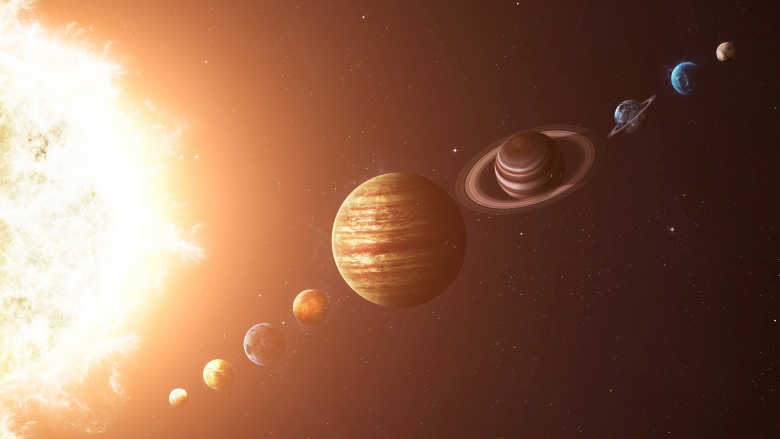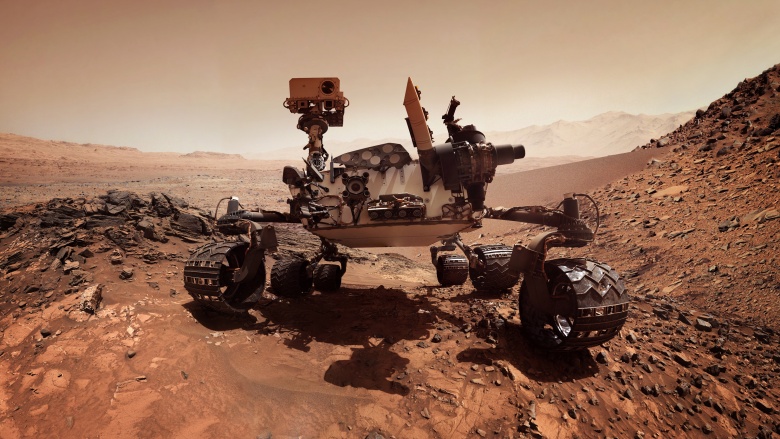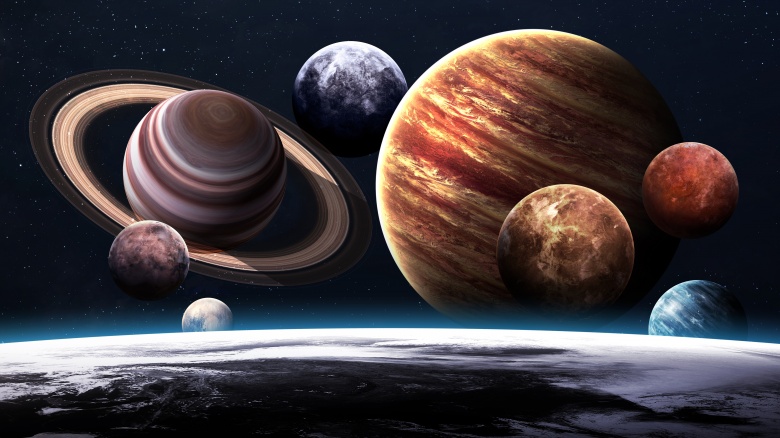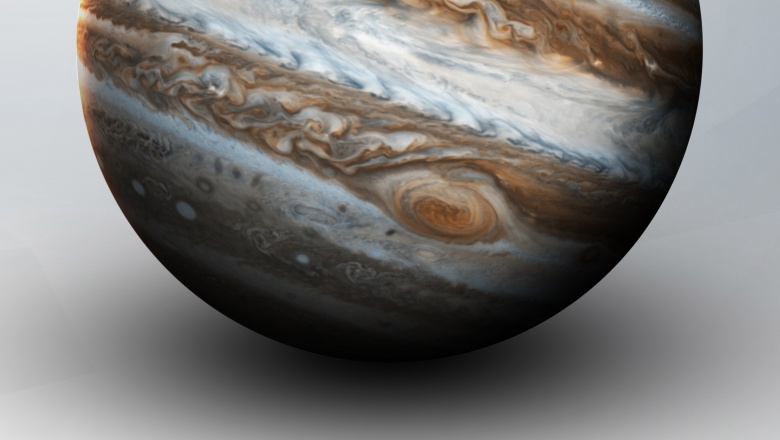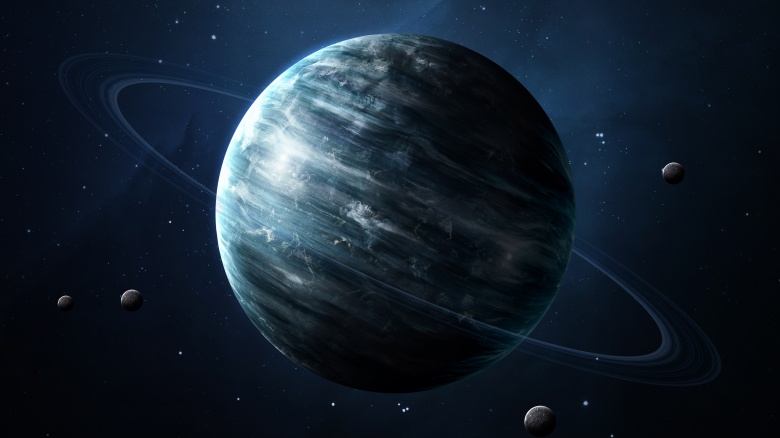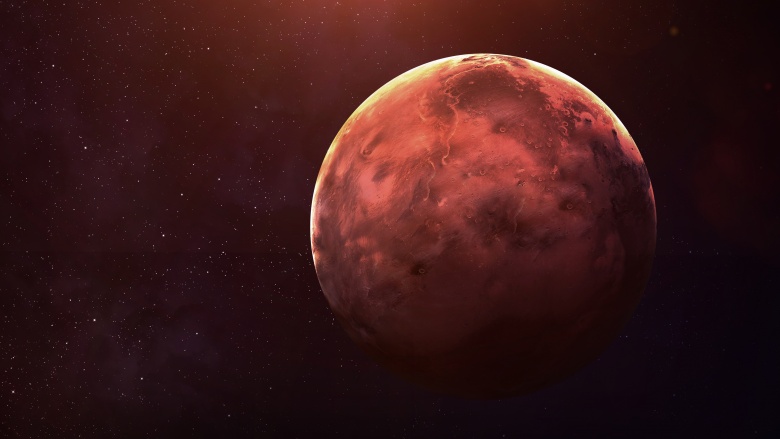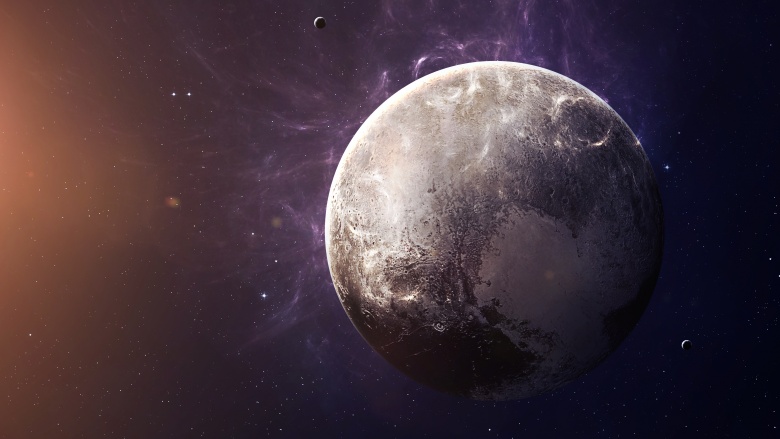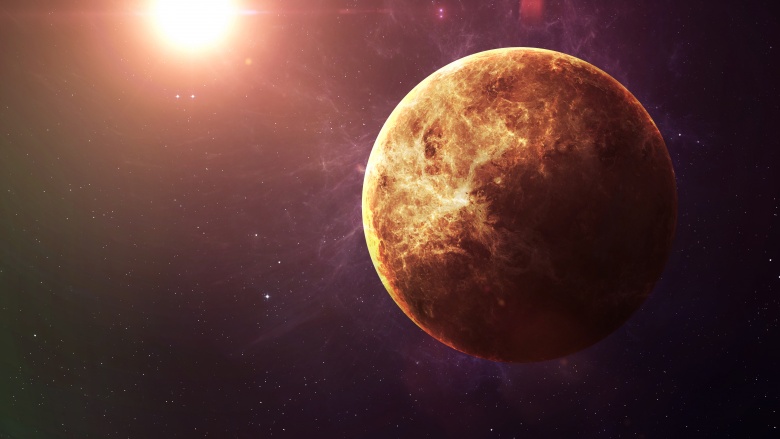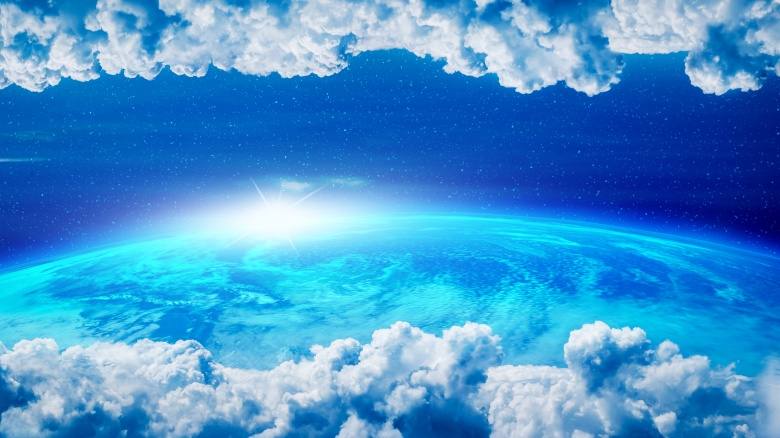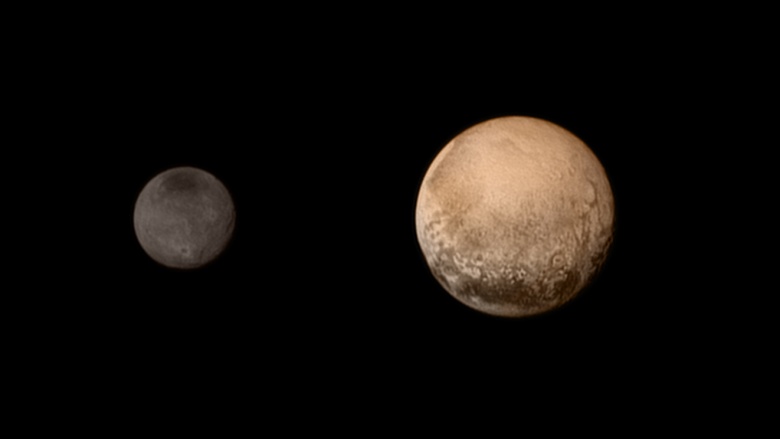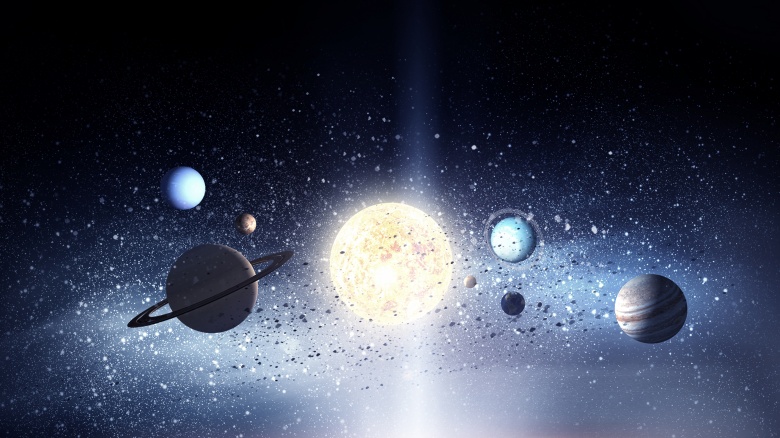False Facts About Other Planets You Always Thought Were True
Space, said Douglas Adams, is big. Really big. That's the best definition we can think of, and we're pretty sure it's not wrong. There are, however, a whole bunch of space things you think you're right about, including facts about our neighboring planets and ... we're here to tell you that you're absolutely wrong about many of them. It's not your fault, really. If you paid attention in science class, that's probably where you picked most of these up. Thanks, teachers!
The planets in our solar system revolve around the sun
It's one of the first things you probably remember learning in science class, and it's wrong. We can't tell kids everything, after all — they'd never want to grow up and besides, their brains aren't fully there yet. We need to simplify things for them. The trouble with this one is that no one ever bothered to explain the truth.
The planets (yep, even including Earth) technically are revolving around something, and it's the center of the mass of the solar system. It's not exactly the Sun, which actually contains about 99.87%(ish) of that mass we mentioned. But, depending on where the planets are in relation to the Sun, the balance is always changing. That means that sometimes, the planets are revolving their way around a point that's sort of close to the Sun's core, and sometimes, it's a point that's not even on the sun. With the right planetary alignment, we're all orbiting our way around a point above the surface of the Sun, and Jupiter? Jupiter does that all the time.
Time for some science stuff. Take the mass of all the non-Jupiter planets in the solar system. Multiply that by 2.5, and you have the mass of Jupiter itself. That's no small potatoes, and that means that Jupiter is so big, it's constantly orbiting a spot (technically called the barycenter) that lies 7% of the Sun's radius above the surface of old Sol. Jupiter isn't just revolving around an imaginary point above the Sun, either — it's pulling with enough force to make to make the Sun wobble just a bit. Technically, all bodies that revolve around each other have this wobbly relationship, but it's only Jupiter that's big enough to make the effect noticeable. And that makes Jupiter pretty badass, stuck in a cosmic tug-of-war with the Sun, like a pitbull mommy playing with her puppy.
Mars, the Red Planet, is, well, red
Quick, what color is Mars? You know, the Red Planet? The one that the ancient Egyptians called Har delcher, or Red One? Yea, that one. We'll give you a hint: it's not red.
There's a couple of different things at work here, and one is rust. The surface of Mars appears red from our vantage point, in part because it's covered in a layer of iron oxide dust. "That makes it red," you argue, to which we say, "Shush." That dust is, in places, only a millimeter or so thick, so technically, that makes the surface not red in the same way you wouldn't call the color of all your bookshelves "dust-colored".
That dust didn't come from any reaction with water, either, and researchers at the Mars Simulation Laboratory think that it was formed from the action of Martian winds reacting with dirt and dust to turn that dust red. (This isn't dust in terms of what you think of Earth dust being like, either. This dust is incredibly fine, and carries enough of an electrostatic charge to be a problem for equipment we've sent there.)
One other thing. Some of the equipment we've sent to Mars has been outfitted with gear that should, in theory, allow it to determine just what color things like rocks and, well, other rocks actually are. The equipment is calibrated, but there's a problem. The planet's atmosphere is so different from Earth's, we're not really sure how exactly we should be calibrating these cameras, and panoramic shots from different times in the day seem to suggest that Mars has all the color-changing abilities of a chameleon. That's insane, though — clearly, it has a color. We just have no idea what it really is. No wonder sci-fi movies give solving this particular problem a miss, and just go with the default "red".
Only Saturn has rings
Have most people sketch the planets, and you'll probably have some big ones, some little ones, and just one with rings: Saturn. That is wrong. Jupiter, Neptune and Uranus also have rings, they're just not as noticeable as the ones around Saturn. It's also likely that wasn't always the case — if we could get a glimpse at what the gas giants looked like, say, 10 million years ago, others probably would have been sporting the bling Saturn boasts today. That's because the rings aren't stable, and they're always changing.
Galileo first saw Saturn's rings back in 1610, but it wasn't until the 1800s that astronomers realized the disc that seemed to be floating around Saturn wasn't just a disc. Now, we know that there's 12 individual rings around the planet, and those rings have Saturn's moons captured within them.
As for the other planets? Uranus actually has more rings than Saturn, 13 in all, and it also has the newest rings of the group. They only formed around 600 million years ago (for space, that's new), and since most are only a few miles wide, it's no surprise that we missed them for so long. We didn't even know about Jupiter's rings until 1979, and the giant planet's four rings mostly contain debris that's been created by various impacts over the years. And Neptune? No one knew Neptune had rings until 1989 (six of them, likely made up of radiation-blasted compounds). You might have missed that news if you were distracted by the brand, spankin'-new technological wonder that had just hit the market. That was, of course, the Game Boy.
Jupiter's Great Red Spot is red
Quick, what color is Jupiter's Great Red Spot? Hint: this is Mars all over again. You're not going to say "Red!" again? You've learned, and that's a good thing.
First, a bit about what it is. The so-called Great Red Spot is a storm, one that's about 12,400 miles wide. (For comparison, the longest distance from America's east coast to its west is 2,892 miles.) Winds in the storm are estimated at about 425 mph, and that makes the whole thing the stuff of sci-fi nightmares. We're not entirely sure when it was first discovered, but we think it might have been recorded in 1665, and that makes it even weirder. It should have burned itself out a long time ago, but it's continued in this strange sort of space vortex.
Right, so the color. When the spot was thoroughly documented in the 1880s, it was a dark color that Crayola would call "brick red." Given that the earliest references to its name "Great Red Spot" date to around the 1870s, that's logical enough. But in the decades before that, the spot was more of a pink color (Primrose, maybe? Or the horribly named Piggy Pink?), and it's also been described as violet. (We prefer Razzmic Berry because seriously, who names these?) Today, Jupiter's Great Red Spot is orange, though who knows what it'll decide to be tomorrow.
Uranus was always called Uranus
Go on, snicker away. Get it out of your system. If there's anything that you remember about taking some astronomy classes, it's probably that getting the chance to say "Uranus" is never, ever not funny. (For the record, NASA says it's actually pronounced Yoor-un-us, but no word on how many NASA scientists even say it that way.)
That's not what we're here to talk about, though. You probably think that they just named the planet Uranus and that was it. That's how names work, after all, but for more than half a century it was something else. Discovered in 1781, the planet was originally named Georgium Sidus. That was Sir William Herschel's idea, and he wanted to get in good with his patron, King George III. The name literally means "George's Star," which would've made it a whole bunch of confusing to put "star" in the name of a planet. Like kids don't have enough to get confused about.
The name was debated for a long time, especially in the astronomical community outside of Britain. They weren't huge fans, and they opted for Uranus, in the tradition of naming the planets after the ancient gods. (Even they didn't seem to study up much, as Uranus was a Greek deity, while all the other gods we've named planets after are Roman.) It wasn't until 1850 that the name "Uranus" became widely accepted, and seriously, people? 69 years and you couldn't ... come up with something ... that's not "Uranus" ... and, we'll just stop that train of thought right there.
Mercury is the hottest planet
Seems like a given, right? It's the closest to the Sun, after all, and we all know that the Sun makes things hot. So, Mercury should be the hottest, right?
Nope. Mercury isn't even consistently hot, and its temperature can fluctuate between 801 and minus 279 degrees Fahrenheit. Its average temperature is still a sweltering 332 degrees, but that doesn't even come close to the average temperature of Venus. Head there, and you'll find an average temperature that makes Arizona in August look positively arctic: 864 degrees.
That's no small difference, although if you ask us, once it gets above 80, it's still all in the same realm of "uncomfortable." While Venus is kept hot by an atmosphere that's the space equivalent of a wool blanket, footie pajamas and a bobble hat, Mercury's more of the lingerie type. Weirdly, it's Mercury's up-close-and-personal relationship with the Sun that keeps it from having any kind of atmosphere, and it's that lack of atmosphere that means most of the solar rays that are constantly bombarding the planet just slip away, rather than heating up the surface. And that means that, if you don't remember anything else about the planets for the rest of your life, you'll always remember that Mercury is fickle and has no idea what it wants.
It's dark on Pluto
We know that Pluto's not technically a planet anywmore, but it spent 75 years as one, and in that time it created quite the reputation and collected the misconceptions to go along with it. Here's one: as the farthest "planet" from the Sun, it's easy to assume that Pluto would be pretty dark. That's absolutely not the case, and the Sun's rays reach way, way farther than you'd expect.
There's a mathematical equation you can use to figure out how bright the Sun looks, and since we slept through almost all our math classes, we're a bit unclear on how and why this all works. Basically, math geniuses say it all has to do with the size of a sphere, the amount of light passing through it, and the distance the target is from that sphere. Math is boring, so we'll skip ahead to the comparisons and start with something that'll give you a practical idea of what we're talking about.
Take the sight of the Sun from Earth, and compare it with the brightness of the full moon. Mathematically speaking, the sun is around 400,000 times brighter than the moon, which makes sense. Now, imagine you're standing (shivering) on Pluto, looking up at the Sun. What you'd see is a bright spot in the sky that looks 250 times brighter than the full moon looks to us here on Earth. That's not enough to give you anything approaching a decent tan, but you wouldn't be stumbling around in the dark, either. Think, instead, Belfast in the winter.
Venus and Earth only have size in common
You've probably heard Venus described as Earth's twin, and usually, that's a reference to the size similarity. That's about it ... right?
Nope. Venus and Earth also share an incredibly similar chemical makeup, although the presence of those chemicals is about where the similarity ends. There's a lot of carbon dioxide in both atmospheres, for example, but there's way, way more of it on Venus than there is on Earth. The really troubling thing is, some scientists point to this fact when claiming Venus can be seen as a sort of prediction for what might happen on Earth, if global warming and climate change aren't stopped. After all, not even the biggest beach bum wants to live on the hottest planet in the solar system. Because there would be no beaches.
In addition to having things like hydrogen, helium and oxygen, Venus also has water ... only it's leaving the planet's atmosphere, rather than staying put. If it covered the planet's incredibly dry surface, this water it would only be about an inch deep. There's clouds, too, and the closest sort of thing we have on Earth is smog.
Droplets fall from Venus's clouds just as they do from ours, but Venus isn't considered Earth's hell-born twin for nothing — her rain is sulphuric acid. Oh, and there's one other thing her storms share with Earth (even though there's not supposed to be any way for it to be possible). Storms on Venus also include lightning, a recent, and huge, discovery that suggests the atmosphere is undergoing some important changes right this minute. It also makes life on Venus just a little bit worse, because as if sulphuric rain wasn't bad enough, now you can get struck by lightning too.
Astronomers found a blue planet like ours
In 2013, the Hubble found a planet that's about 63 light years from us, and it's blue! It was given the name HD189733b, which sounds like a preppy android's middle name. Not only was it blue, they found, but it had an atmosphere! How exciting is this? It's not just another rock-colored rock — it's a planet with all the beautiful colors that make our planet look so absolutely superior from space.
Sadly, that's about all they have in common. A closer look at the planet suggests that it was written into the universe by a 13-year-old sci-fi nerd writing Star Trek fanfiction. The Jupiter-sized planet orbits its star in 2.2 days, has winds that reach speeds up to 5,400 mph (that's seven times the speed of sound), has daytime temperatures of 1,700 Fahrenheit, and rain. Wait, rain? That's good, right? Rain on HD189733b isn't water, though, it's molten glass. And in all fairness, it's not really rain like we think of it, either. It's sideways rain, because regular rain? So common.
All planets are clearly defined as planets (and Earth almost wasn't one, either)
This one brings us back to Pluto. In 2006, astronomers finally removed Pluto's official designation of "planet", and made it a "dwarf planet." Not a few people in the astronomical world were a bit embarrassed, and some of that embarrassment had to do with how no one was really quite sure just what exactly a planet was.
You expect scientific definitions to be pretty clear about things, but at the time they were arguing about Pluto's status, a planet only needed to meet a few pretty non-specific criteria to actually be called a planet. One of those things was that the body needed to have cleared its orbit of any other sort of bodies and space debris that wasn't one of its satellites. That was an obvious problem for Pluto, as it's right in the middle of the Kuiper asteroid belt. But ... it's also a problem for Earth. Our own planet is surrounded by thousands and thousands of asteroids, and we haven't cleared our orbit like the definition suggested. If that's not enough, according to that particular definition, Jupiter would be kicked out of Club Planet, too.
So, the International Astronomical Union had to do a little bit of creative re-writing to get the definition to fit all the planets they wanted to include (including ours, because we're the coolest kids on the block, and Jupiter because it's the toughest and you want to keep it happy), and keep out the not-cool kids. They changed it to include the idea that not clearing their orbit was alright after all, but the planet in question needed to be a lot bigger than the bodies around it. Earth and Jupiter are, but Pluto's not. Sorry Pluto, looks like you're eating lunch alone after all.
There's eight planets in the solar system
After the whole Pluto debacle, everyone seemed pretty confident that we finally had this whole planet thing nailed. Not quite, and we're almost 100% sure there's more than eight planets in the solar system ... but none of them are Pluto.
In January of 2016, scientists officially announced their evidence for a massive planet that orbits our sun every 15,000 (Earth) years, and has a mass that's somewhere around 10 times that of Earth. Its presence seems to be heralded by a cluster of objects that could only have been drawn in by the pull of a massive planet, but given that it's around seven times farther away from the Sun than Neptune is, it's not going to be passing by any time soon. And it might not be alone, with other scientists suggesting that the data says there's two planets lurking out there on the fringes of the known solar system. It's the only explanation for some of the anomalies found in various computer simulations, which all seem to suggest our solar system has some creepy lurkers hiding out in the darkness.
Maybe they're afraid of getting demoted by our arbitrary definitions ... or maybe, they're just afraid of us.

